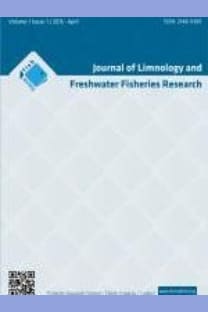Scenedesmus obliquus Suşlarının Farklı Besin Ortamlarındaki Büyüme Kinetiği
Growth Kinetics of Scenedesmus obliquus Strains in Different Nutrient Media
___
- Al-Shatri AH, Ali E, Al-Shorgani NK, Kalil MS. 2014. Growth of Scenedesmus dimorphus in different algal media and pH profile due to secreted metabolites. Afr J Biotechnol. 13 (16):1714-1720. doi: 10.5897/AJB2013.13455
- Andersen RA, Berges JA, Harrison PJ. 2005. Recipes for freshwater and seawater media. In: Andersen RA editor. Algal culturing techniques. London: Elsevier Academic Press. p. 429-538.
- Bhamawat PM. 2010. Growth of Chlamydomonas reinhardtii under nutrient-limited conditions in steady-state bioreactors [Master's Thesis]. Faculty of the Graduate School of Cornell University. 83 p.
- Blair MF, Kokabian B, Gude VG. 2013. Light and growth medium effect on Chlorella vulgaris biomass production. Journal of Environmental Chemical Engineering. 2(1):665-674. doi: 10.1016/j.jece.2013.11.005
- Brennan L, Owende P. 2010. Biofuels form microalgae a review of technologies for production, processing and extractions of biofuels and co-products. Renew Sust Energ Rev. 14(2):557-577. doi: 10.1016/j.rser.2009.10.009
- Chen M, Li L, Dai X, Sun Y, Chen F. 2011. Effect of phosphorus and temperature on chlorophyll a contents and cell sizes of Scenedesmus obliquus and Microcystis aeruginosa. Limnology. 12(2):187-192. doi: 10.1007/s10201-010-0336-y
- Chia MA, Lombardi AT, Melao MGG. 2013. Growth and biochemical composition of Chlorella vulgaris in different growth media. Annals of the Brazilian Academy of Sciences. 85(4):1427-1438. doi: 10.1590/0001-3765201393312
- Chu ZS, Jin XC, Yan F, Zheng SF, Pang Y, Zeng QR. 2007. Effects of EDTA and iron on growth and competition of Microcystis aeruginosa and Scenedesmus quadricauda. Huanjing Kexue/Environ Sci. 28(11): 2457-2461.
- Eida MF, Darwesh OM, Matter IA. 2018. Cultivation of oleaginous microalgae Scenedesmus obliquus on secondary treated municipal wastewater as growth medium for biodiesel production. Journal of Ecological Engineering. 19(5):38-51. doi: 10.12911/22998993/91274
- Fallahi M, Rahbary SH, Shamsaii M. 2014. Determination of optimum concentration of diuron for the growth and bloom of the algae (Scenedesmus obliquus) in in vitro condition. Iran J Fish Sci. 13(3):739-747.
- Godoy-Hernández G, Vázquez-Flota FA. 2006. Growth measurements: estimation of cell division and cell expansion. In: Loyola-Vargas VM, Vázquez-Flota F. editors. Methods in molecular biology. New Jersey: Humana Press Inc. 877:41-48.
- Guillard RRL, Sierachiki MS 2005. Counting cells in cultures with the light microscope. In: Andersen RA editor. Algal culturing techniques. London: Elsevier Academic Press. p. 239-252.
- Guiry MD, Guiry GM. 2018. AlgaeBase; [cited: 2018 Oct 21]. Available from http://www.algaebase.org.
- Hodaifa G, Martínez ME, Sánchez S. 2008. Use of industrial wastewater from olive-oil extraction for biomass production of Scenedesmus obliquus. Bioresource Technol. 99(5):1111-1117. doi: 10.1016/j.biortech.2007.02.020
- Humpry AM. 2004. Chlorophyll as a color and functional ingredient. J Food Sci. 69(5):422-425. doi: 10.1111/j.1365-2621.2004.tb10710.x
- Kabir M, Hoseini SA, Ghorbani R, Kashiri H. 2017. Performance of microalgae Chlorella vulgaris and Scenedesmus obliquus in wastewater treatment of Gomishan (Golestan-Iran) shrimp farms. Aquaculture, Aquarium, Conservation and Legislation - International Journal of the Bioflux Society. 10(3):622-632.
- Latiffi NAA, Mohamed RM, Apandi NM, Tajuddin RM. 2017. Preliminary assessment of growth rates on different concentration of microalgae Scenedesmussp. in industrial meat food processing wastewater. International Symposium On Civil And Environmental Engineering. 103: 1-9. doi: 10.1051/matecconf/20171030
- Liang K, Zhang Q, Gu M, Cong W. 2013. Effect of phosphorus on lipid accumulation in freshwater microalgae Chlorella sp. J Appl Phycol. 25(1):311-318. doi: 10.1007/s10811-012-9865-6
- Murdock JN, Wetzel DL. 2009. FT-IR Microspectroscopy enhances biological and ecological analysis of algae. Appl Spectroscopy Rev. 44(4):335-361. doi: 10.1080/05704920902907440
- Parvin M, Zannat MN, Habib MAB. 2007. Two important technique for isolation of microalgae. Asian Fisheries Science. 20:117-124.
- Prescott GW. 1973. Algae of the western great lakes area. Michigan: C. Brown Company Publishers 977 p. Pringsheim E. 1946. Pure cultures of algae. Cambridge: University Press 119 p.
- Rasmussen RS, Morrissey T, Steve LT. 2007. Marine biotechnology for production of food ingredients. Advances in Food and Nutrition Research. 237-292. doi: 10.1016/S1043-4526(06)52005-4
- Rinanti A, Kardena E, Astuti DI, Dewi K. 2013. Growth response and chlorophyll content of Scenedesmus obliquus cultivated in different artificial media. Asian Journal of Environmental Biology. 1(1):1-9. doi: 10.13140/RG.2.1.3370.7926
- Salama ES, Kim HC, Abou-Shanab RAI et al. 2013. Biomass, lipid content, and fatty acid composition of freshwater Chlamydomonas mexicana and Scenedesmus obliquus grown under salt stress. Bioproc Biosyst Eng. 36(6):827-833. doi: 10.1007/s00449-013-0919-1
- Sforza E, Gris B, Silva C, Morosinotto T, Bertucco A. 2014. Effects of light on cultivation Scenedesmus obliquus in batch and continuous flat plate photobioreactor. Chemical Engineering Transactions. 38:211-216. doi: 10.3303/CET1438036
- Shelly K, Heraud P, Beardall J. 2002. Nitrogen limitation in Dunaliella tertiolecta (Chlorophyceae) leads to increased susceptibility to damage by UV-B radiation but also increased repair capacity. J Phycol. 38:1-8. doi: 10.1046/j.1529-8817.2002.01147.x
- Toyub MA, Miah MI, Habib MAB, Rahman MM. 2008. Growth performance and nutritional value of Scenedesmus obliquus cultured in different concentrations of sweetmeat factory waste media. Bangladesh Journal of Animal Science. 37(1):86-93. doi: 10.3329/bjas.v37i1.9874
- Wang B, Li Y, Wu N, Lan CQ. 2008. CO2 bio-mitigation using microalgae. Appl Microbiol Biot 79(5):707- 718. doi: 10.1007/s00253-008-1518-y
- Youngman RE. 1978. Measurement of chlorophyll-a. New York: Water Research Centre Technical Report. Report No: TR82.
- ISSN: 2148-9300
- Yayın Aralığı: 3
- Başlangıç: 2015
- Yayıncı: Su Ürünleri Araştırma Enstitüsü Müdürlüğü
Soner SAVAŞER, Ufuk AKÇİMEN, Mustafa CEYLAN, Zübeyde HANOL BEKTAŞ, Osman YENER, Cafer BULUT
Nüket AKANIL BİNGÖL, Betül AKIN
The Gastropod Fauna of the Afyon-Dinar İncirlipınar Spring, Turkey
MEHMET ZEKİ YILDIRIM, MUSTAFA EMRE GÜRLEK
Afyon-Dinar İncirlipınar Su Kaynağı Gastropod Faunası
Mustafa Emre GÜRLEK, Mehmet Zeki YILDIRIM
Su Ürünlerinde Doğal Zeolit (Klinoptilolit) ile Amonyum Adsorpsiyonu
Meryem ÖZ, Ünal ÖZ, Orhan ARAL, Dilek ŞAHİN, Zafer KARSLI, Eda SERTAŞI
Ayvalı Deresinin Kirlilik Potansiyelinin Belirlenmesi
Enis AKAY, Selman KANDER, F. Olcay TOPAÇ ŞAĞBAN
Yağlıdere Çayı (Giresun)’nın Bakteriyolojik Kirlilik Düzeyinin Belirlenmesi
Cengiz MUTLU, Tamer AKKAN, Sultan MEHEL
Seda İmert AYDOĞDU, Yaşar ÖZDEMİR
DİLEK ŞAHİN, MERYEM ÖZ, Eda SERTAŞI, ÜNAL ÖZ, ZAFER KARSLI, MUSTAFA ORHAN ARAL
